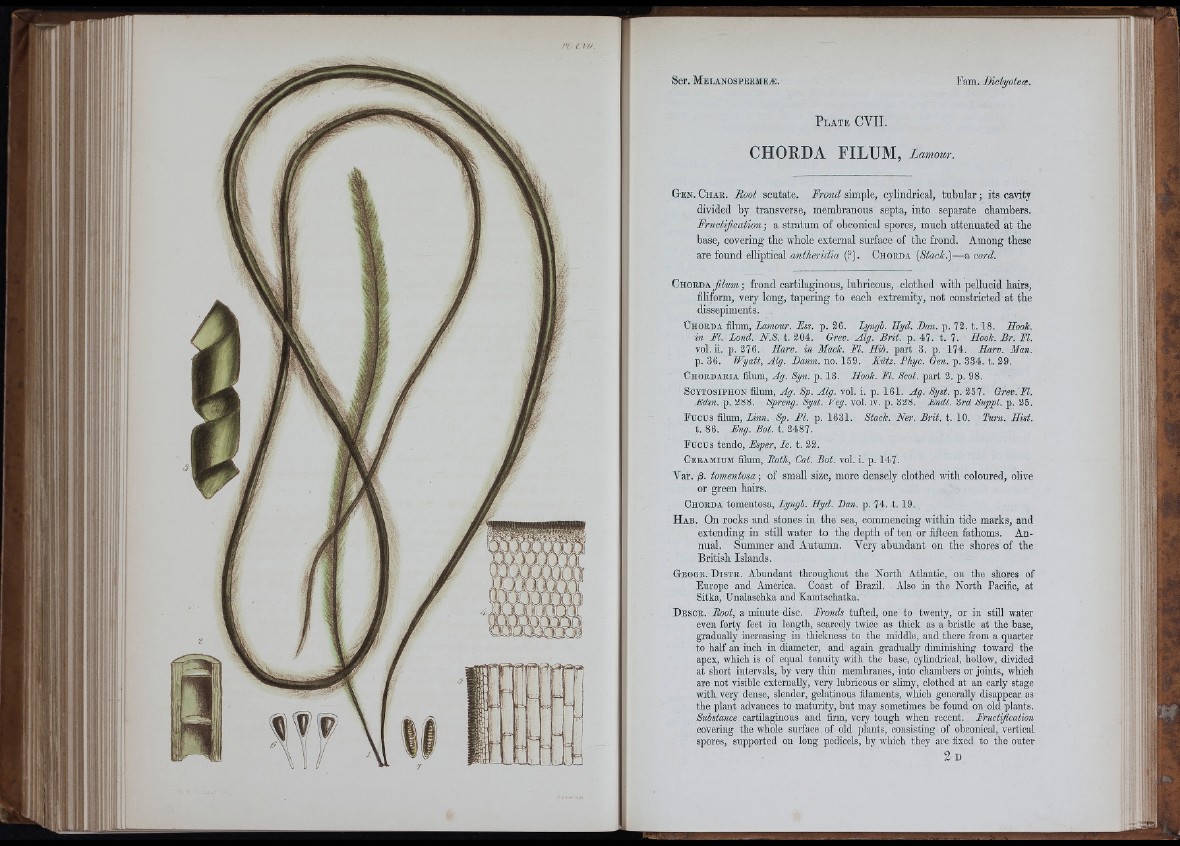
P l a t e C V I I .
CHORDA FILUM, Lamour.
G e n . C h a r . Root scutate. Frond simple, cylindrical, tubular; its cavity
divided by transverse, membranous septa, into separate chambers.
Fructification; a stratum of obconical spores, much attenuated at the
base, covering the whole external surface of the frond. Among these
are found elliptical antheridia (?). C h o r d a [Stack.)—a cord.
C h o r d a frond cartilaginous, lubricous, clothed with peUucid hairs,
filiform, very long, tapermg to each extremity, not constricted at the
dissepiments.
Chorda filum, Lamour. Ess. p. 26, Lyngi. Eyd. .Dan. p. 72. t, 18. Hook,
in M. Lond. N.S. t. 204. Grev. Alg. Brit. p. 47. t. 7. Hook. Br. El.
vol.ii. p. 276. Harv. in Mack. El. H ii. part 3. p. 174. Harv. Man.
p. 36. Wyatt, Alg. Banm. no. 159. Kiitz. Phyc. Gen. p. 384. t. 29.
C h o r d a r ia filum, Ag. Syn. p . 1 3 . Hook. El. Scot. p a r t 2. p . 9 8 .
Scytosiphon filum, Ag. Sp. Alg. vol. i. p. 161. Ag. Syst. p. 257. Grev. El.
Edin. p. 288. Spreng. Syst. Veg. vol. iv. p. 328. Endl. 3rd Suppl. p. 25.
Pu cu s filum, Linn. Sp. PL p. 1631. Stack. Ner. Brit. t. 10. Turn. Hist.
t. 86. Eng. Bot. t. 2487.
Pu cu s tendo, Esper, Ic. t. 22.
Ceramium filum, Roth, Cat. Bot. vol. i. p. 147.
Var. tomentosa; of smaU size, more densely clothed with coloured, olive
or green hairs.
C h o r d a tom e n to s a , Lyngb. Hyd. Ban. p . 7 4 . t, 19,
H a b . On rocks and stones in the sea, commencing witlun tide marks, and
extending in still water to the depth of ten or fifteen fathoms. Annual.
Summer and Autumn. Very abundant on the shores of the
British Islands.
Geogr. Distr. Abundant throughout the North Atlantic, ou the shores of
Europe and America. Coast of Brazil. Also in the North Pacific, at
Sitka, Unalaschka aud Kamtschatka.
Descr. Root, a minute disc. Eronds tufted, one to twenty, or in still water
even forty feet in length, scarcely twice as thick as a bristle at the base,
gradually increasing in thickness to the middle, and there from a quarter
to half an inch in diameter, and again graduaUy diminishing toward the
apex, which is of equal tenuity with the base, cylindrical, hollow, divided
at short intervals, by very thin membranes, into chambers or joints, which
are not visible externaUy, very lubricous or sHmy, clothed at an early stage
with very dense, slender, gelatinous filaments, which generaUy disappear as
the plant advances to maturity, but may sometimes be found on old plants.
Substance cartilag-inous and firm, very tough when recent. Eructification
covering the whole surface of old plants, consisting of obconical, vertical
spores, supported on long pedicels, by which they are fixed to the outer
i
' ’■
■4 t o
to.):
■ i ' f;||
:• 4
I ii